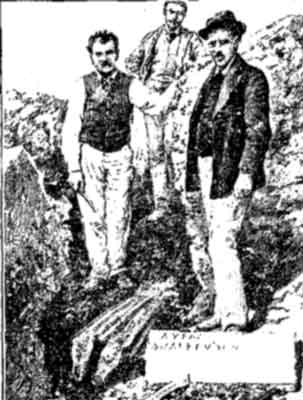.
Der Wagenlenker von Delphi und von Motya
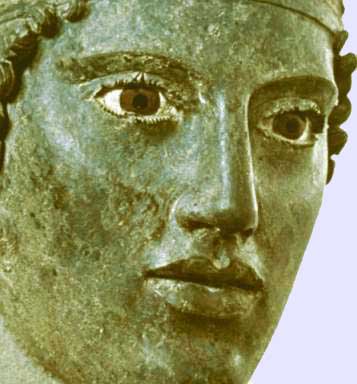
Discovery place of the Charioteer |
 |
The Charioteer (Heniochos) of Delphi found in 1896 by French excavators. His four horses are lost probably by an earthquake around 373 AD. The face is according to specialists asymmetric in order to make it more realistic. His eyes are made of Onyx. The lips are made of cooper and his head band impressed in silver. It is interesting to read what scholars say about the Charioteer, sometimes I think with an extreme idealism: Not only does it celebrate, like the Pythian odes (of Pindar), a victory won at the festival games, but the ethos which it conveys is a manifestation of Pindaric arete... the "innate excellence" of noble natures which gives them proficiency and pride in their human endeavors before the gods. J. J. Pollitt in James Whitley the Archeology of Ancient Greece.
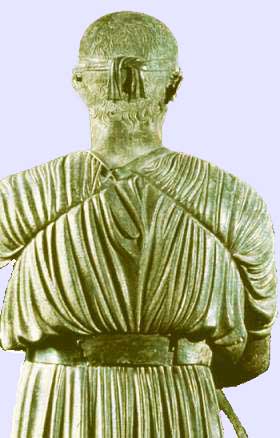
A 1.8 m Bronze Statue “Charioteer of Delphi”. Produced in 7 separate pieces by the sculptor Sotades. The left hand is missing. It is dedicated to Apollo by Polyzalos of Gela, a son of Deinomenos , tyrant of Gela in Sicily, the winner of a Pythian Games chariot race (478/0) BC (From a inscription on the base that survived).
Polyzalos, victorious with his horses dedicated me / son of Deinomenes, whom make prosper, honoured Apollo
The Charioteer has a Chiton fastened well avoiding blown up during the race.
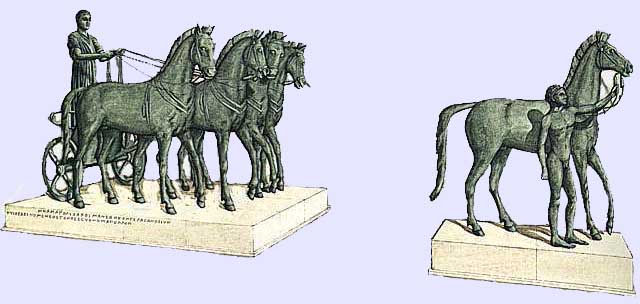
Reconstruction of the Delphi Charioteer Sculpture, part that includes a chariot with four horses and a boy with a horse.

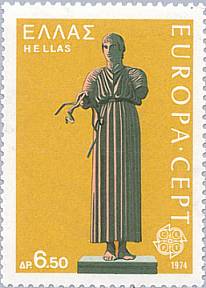
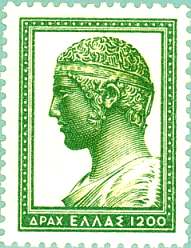
Delphi Charioteer Stamps
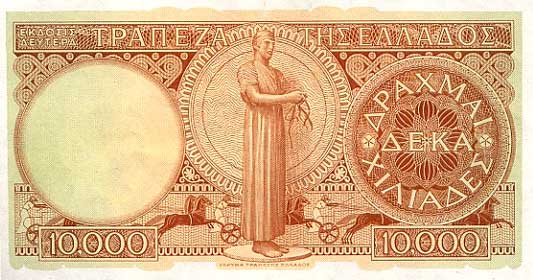
10000 Drachmae, Greece 1947
More Images, including part of the horses see: http://www.ancient-greece.org/art/chiarioteer.html
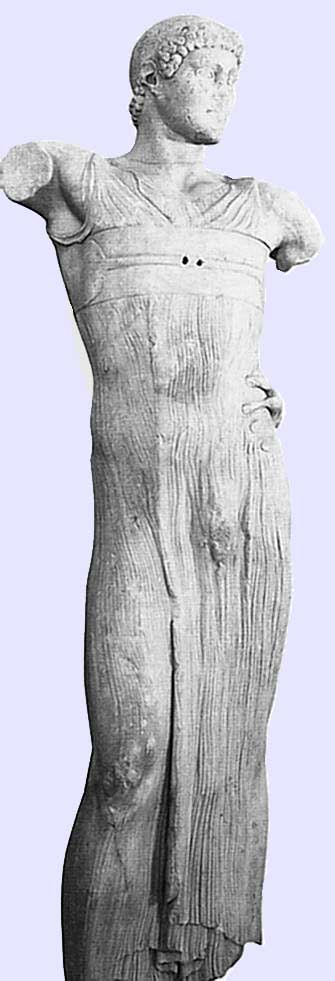
 |
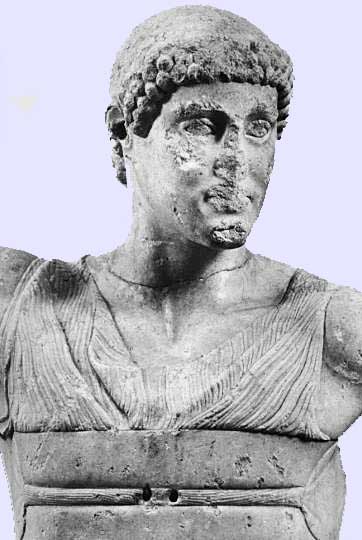 |
Another Charioteer from Motya in Sicily around 480-450 BC, 1.81 meter marble with a long chiton. The sculpture was discovered in 1979, now at the museum (Villa Whittaker) on the island Motya (Mozia). Malcolm Bell persuasively argues that the figure represents a winner in the games, and suggests that the statue would originally have been raised in the subject’s Sicilian home Many features of this visually arresting piece accord with what we know of fifth century victory images. Slightly over life-size (it presently measures 1.81m), the young, beardless athlete places hisweight on his left leg as he stands at rest; the left arm is held akimbo and the right raised above the horizontal. Bell demonstrates how the position of the now missing right forearm and hand should be associated with the four bronze nails in the statue’s cranium, arranged so as to hold a circular object around the charioteer’s head; according to his reading, the athlete would be raising his hand in order to hold or touch the tainia, or maybe the victory wreath... Other elements of the charioteer’s design promote his eye-catching appeal....The viewer’s attention, already drawn to the lower body by the thumb of the left hand pressed up against the hip and indenting the flesh below, then moves to the contours of the statue’s buttocks, .... The chest band running tightly around the charioteer’s chiton, and causing the material to bunch on top, conveys the strength and vitality of the upper abdomen as it strains against the confines, and recalls the effort just expended in the race. ..Deborah Steiner, Moving Images: Fifth-Century Victory Monuments and the Athlete’s Allure, Classical Antiquity 17 ,1998
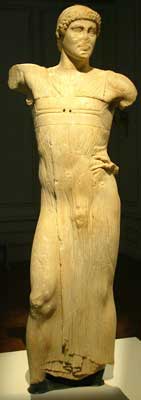
For, on another day, when chariots were to try their speed at sunrise, he entered, with many charioteers. One was an Achaean, one from Sparta, two masters of yoked cars were Libyans; Orestes, driving Thessalian mares, came fifth among them; the sixth from Aetolia, with chestnut colts; a Magnesian was the seventh; the eighth, with white horses, was of Aenian stock; the ninth, from Athens, built of gods; there was a Boeotian too, making the tenth chariot. They took their stations where the appointed umpires placed them by lot and ranged the cars; then, at the sound of the brazen trump, they started. All shouted to their horses, and shook the reins in their hands; the whole course was filled with the noise of rattling chariots; the dust flew upward; and all, in a confused throng, plied their goads unsparingly, each of them striving to pass the wheels and the snorting steeds of his rivals; for alike at their backs and at their rolling wheels the breath of the horses foamed and smote. Orestes, driving close to the pillar at either end of the course, almost grazed it with his wheel each time, and, giving rein to the trace-horse on the right, checked the horse on the inner side. Hitherto, all the chariots had escaped overthrow; but presently the Aenian's hard-mouthed colts ran away, and, swerving, as they passed from the sixth into the seventh round, dashed their foreheads against the team of the Barcaean. Other mishaps followed the first, shock on shock and crash on crash, till the whole race-ground of Crisa was strewn with the wreck of the chariots. Seeing this, the wary charioteer from Athens drew aside and paused, allowing the billow of chariots, surging in mid course, to go by. Orestes was driving last, keeping his horses behind,- for his trust was in the end; but when he saw that the Athenian was alone left in, he sent a shrill cry ringing through the ears of his swift colts, and gave chase. Team was brought level with team, and so they raced,-first one man, then the other. showing his head in front of the chariots. Hitherto the ill-fated Orestes had passed safely through every round, steadfast in his steadfast car; at last, slackening his left rein while the horse was turning, unawares he struck the edge of the pillar; he broke the axle-box in twain; he was thrown over the chariot-rail; he was caught in the shapely reins; and, as he fell on the ground, his colts were scattered into the middle of the course. But when the people saw him fallen from the car, a cry of pity went up for the youth, who had done such deeds and was meeting such a doom,- now dashed to earth, now tossed feet uppermost to the sky,- till the charioteers, with difficulty checking the career of his horses, loosed him, so covered with blood that no friend who saw it would have known the hapless corpse. Straightway they burned it on a pyre; and chosen men of Phocis are bringing in a small urn of bronze the sad dust of that mighty form, to find due burial in his fatherland. Sophocles Electra
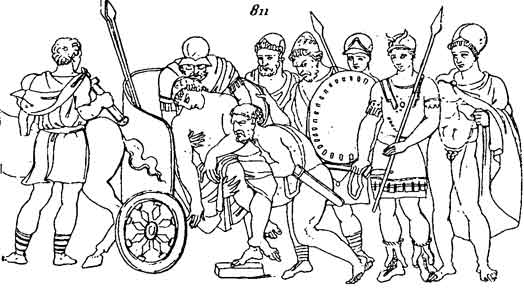
Dead Antilochus carried in the chariot of Nestor
Antilochos the fourth driver, the glorious son of Nestor, that king of lofty heart, the son of Neleus, got ready his horses with gleaming coats. Swift horses born in the land of Pylos drew his chariot. And his father, standing by his side, giving good advice to one who was himself naturally prudent, spoke wisely thus: `Antilochos, although you are very young, Zeus and Poseidon have both loved you and taught you all kinds of skills at driving a chariot; therefore we need not teach you, for you know how skilfully to turn around the post. But your horses are the slowest. I therefore think that the race will be sorrowful to you. True, their horses are swifter, but the drivers do not know more than you. And so, my son, contrive a plan in your heart, so that the prize will not elude you ... Drive chariot and horses so close to this (the post) as to graze it, and lean the well wrought car slightly to the left horse, and calling upon the right horse by name, prick him with your goad and let out its reins from your hand. Let your horses graze the post so that the hub of the well fashioned wheel will seem to touch it. But avoid making contact with the stone, so that you will not injure your horses and wreck your chariot, which would be a joy for your opponents and a distress to you. Homer Iliad XXIII
| Ancient Greece
Science, Technology , Medicine , Warfare, , Biographies , Life , Cities/Places/Maps , Arts , Literature , Philosophy ,Olympics, Mythology , History , Images Medieval Greece / Byzantine Empire Science, Technology, Arts, , Warfare , Literature, Biographies, Icons, History Modern Greece Cities, Islands, Regions, Fauna/Flora ,Biographies , History , Warfare, Science/Technology, Literature, Music , Arts , Film/Actors , Sport , Fashion --- |

